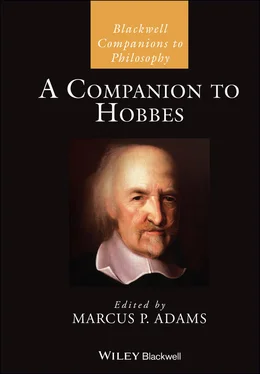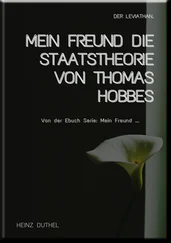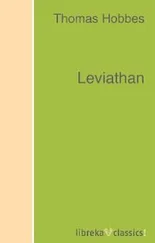9 Hanson, Donald W. 1990. “The Meaning of ‘Demonstration’ in Hobbes’s Science.” History of Political Thought 11: 587–626.
10 Hattab, Helen. 2009. Descartes on Forms and Mechanisms. Cambridge: Cambridge University Press.
11 Hattab, Helen. 2011. “The Mechanical Philosophy.” In The Oxford Handbook of Philosophy in Early Modern Europe, edited by Desmond Clarkeand Catherine Wilson, 124–64. Oxford: Oxford University Press.
12 Hattab, Helen. 2014. “Hobbes’ and Zabarella’s Methods: A Missing Link.” Journal of the History of Philosophy 52 (3): 461–85.
13 Hattab, Helen. 2019. “Descartes’ Mechanical but Not Mechanistic Physics.” In The Oxford Handbook of Descartes and Cartesianism, edited by Delphine Antoine-Mahut, Steve Nadler, and Tad Schmaltz, 124–37. Oxford: Oxford University Press.
14 Hobbes, Thomas. 1999. De Corpore Elementorum Philosophiae Sectio Prima, edited by Karl Schuhmannand Martine Pécharman. Paris: Librairie Philosophique J. Vrin.
15 Hobbes, Thomas. 2012. Leviathan.3 vols., edited by Noel Malcolm. Oxford: Clarendon Press. [First published 1651].
16 Hungerland, Isabel C.and George R. Vick. 1981. “Misinterpretations of Hobbes: The Correct View.” In Thomas Hobbes Computatio Sive Logica, edited by Aloysuis P. Martinich, Isabel C. Hungerland, and George R. Vick, 15–148. New York: Abaris Books.
17 Jesseph, Douglas. 2004. “Galileo, Hobbes, and the Book of Nature.” Perspectives on Science 12 (2): 191–211.
18 Keckermann, Bartholomaeus. 1613. Systema Logicae. Hanover: Apud Haeredes Guilielmi Antonii.
19 MacPherson, C.B.1968. “Introduction.” In Leviathan, edited by C.B. MacPherson, 25–9. Hammondsworth: Penguin.
20 Prins, Johan1990. “Hobbes and the School of Padua: Two Incompatible Approaches to Science.” Archiv für Geschichte de Philosophie 72: 26–46.
21 Röd, Wolfgang. 1970. Geometrischer Geist und Naturrecht, Methodengeschichtliche Untersuchungen zur Staatsphilosophie im 17. Und 18. Jahrhundert. Munich: Verlag der Bayerischen Akademie der Wissenschaften.
22 Sacksteder, William. 1980. “Hobbes: The Art of the Geometricians.” Journal of the History of Philosophy 18 (2): 131–46.
23 Sacksteder, William. 1988. “Notes and Discussions: Hobbes and Talaska on the Order of the Sciences.” Journal of the History of Philosophy 26 (4): 643–7.
24 Schmidt-Biggemann, Wilhelm. 2001. “Die Schulphilosophie in den reformierten Territorien.” In Die Philosophie des 17.Jahrhunderts, Vol.4: Das Heilige Römische Reich Deutscher Nation Nord- und Mittelosteuropa, editedby Helmut Holzeheyand Wilhelm Schmidt-Biggemann, 390–474. Basel: Schwabe & Co AG Verlag.
25 Schuhmann, Karl. 1987. “Methodenfragen bei Spinoza und Hobbes: Zum Problem des Einflusses.” Studia Spinoziana 3: 47–86.
26 Sorell, Tom. 1999. Hobbes. London: Routledge and Kegan Paul.
27 Sparn, Walter. 2001. “Die Schulphilosophie in den luthersichen Territorien.” In Die Philosophie des 17.Jahrhunderts, Vol.4: Das Heilige Römische Reich Deutscher Nation Nord- und Mittelosteuropa, edited by Helmut Holzeheyand Wilhelm Schmidt-Biggemann, 475–587. Basel: Schwabe & Co AG Verlag.
28 Talaska, Richard A.1988. “Analytic and Synthetic Method according to Hobbes.” Journal of the History of Philosophy 26 (2): 207–37.
29 Watkins, John N.1973. Hobbes’s System of Ideas. London: Hutchinson University Library.
30 Zabarella, Jacobus. 1597. Opera Logica. Cologne: Sumptibus Lazari Zetzneri.
1 1 Hobbes exhorts those with a sincere desire to be philosophers to “let your reason move upon the deep of your own cogitations and experience; those things that lie in confusion must be set asunder, distinguished, and every one stamped with its own name set in order; that is to say your method must resemble that of the creation. The order of the creation was, light, distinction of day and night, the firmament, the luminaries, sensible creatures, man; and after the creation, the commandment. Therefore, the order of contemplation will be, reason, definition, space, the stars, sensible quality, man; and after man is grown up, subjection to command” (EW I. xiii). Hobbes echoes the appeal to two parallel, but separate, sources of insight into truth prevalent in seventeenth-century Calvinist Scholastic textbooks and Francis Bacon’s work: the book of nature and Holy Scripture. Schmidt-Biggemann explains that for seventeenth-century Calvinist Scholastics, “Knowledge was understood as an inventory of the Revelation made available to humankind, as knowledge found in the Bible, History, and Nature. These three ‘books’ were the field of experience which according to God’s creation plan is inventoried in knowledge” (Schmidt-Biggemann 2001, 394; translation mine).
2 2 Meteorology, Optics, and Music were all mixed mathematical sciences in the Scholastic tradition; logic was considered the instrument of philosophy, not part of natural philosophy proper.
3 3 See Hattab (2009, 93–8).
4 4 Hobbes’s division most resembles that of early seventeenth-century Calvinist Scholastic textbooks in which “The framework of metaphysics was theological, not the other way around. Hence one counted metaphysical concepts within natural theology and in this way, natural philosophy and metaphysics were made broadly coextensive” (Schmidt-Biggemann 2001, 394, translation mine). For Hobbes, likewise, topics of traditional Aristotelian metaphysics, like the first cause, its eternity, and the immortality of the soul are relegated to Theology. Remaining metaphysical topics, like the nature of substance, its accidents and causation are absorbed into natural philosophy under Hobbes’s First Philosophy.
5 5 Alessandro Piccolomini and subsequent Aristotelian mathematicians reclassified mechanics, the art of machines, which was traditionally considered a craft, as a mixed mathematical science (Hattab 2009, 93–8). Marcus Adams discusses Hobbes’s treatment of physics as a mixed mathematical science, which following the Aristotelian tradition of such sciences, borrows its principles from the more fundamental science of geometry, and applies them to nature to deduce physical effects (Adams 2017, 84–6). This is also the sense in which Descartes considers his natural philosophy mathematical and mechanical and appears to be a common thread in the so-called early modern “mechanists” (Hattab 2009, 120–35, 2019).
6 6 The English edition misleads since it mistranslates cognitio with “science” in the last sentence, falsely implying that Hobbes counts experience as scientific knowledge: “But we are then said to know any Effect, when we know, that there be Causes of the same, and in what Subiect those Causes are, and in what Subiect they produce that Effect, and in what Manner they work the same. And this is the Science of Causes, or as they call it of the διότι. All other science, which is called the ὅτι, is either Perception by Sense, or the Imagination, or Memory remaining after such Perception” (EW I.48–9).
7 7 This aspect of the generic method generates a persistent misreading of Hobbes’s specific method of analysis as akin to the first phase of Jacopo Zabarella’s regressus, which further gets conflated with a different sense of method in which Zabarella appeals to analysis. For example, see Hanson (1990, 587–626), MacPherson (1968, 25–9), Röd (1970, 10–15), Hungerland and Vick (1981, 25–7), Watkins (1973, 63–5), and Duncan (2003). J. Prins demonstrates how differences between Hobbes’s and Zabarella’s views on logic affect their views on method and scientific knowledge (Prins 1990, 26–46). Jesseph revised his view noting that any number of extant views on analysis and synthesis could have influenced Hobbes’s (Jesseph 2004, 191–211). I show that the regressus, a proof enabling one to deduce a possible natural cause from observed effects, and then in turn, deduce that the possible cause is the actual cause of the natural effect, does not map onto Hobbes’s method. Linking the two stems from substantive confusions between the regressus and what Zabarella calls “method as order.” Zabarella only discusses “analysis” in the context of method as order. Wherever Hobbes gets this label, his sense of “analysis” is unrelated to the regressus and closer to later Scholastics uses than Zabarella’s (Hattab 2014).
Читать дальше












